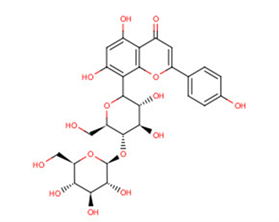
glucosylvitexin
CAS No. 76135-82-5
glucosylvitexin( —— )
Catalog No. M19085 CAS No. 76135-82-5
Glucosylvitexin inhibits TPO activity.
Purity : >98% (HPLC)
 COA
COA
 Datasheet
Datasheet
 HNMR
HNMR
 HPLC
HPLC
 MSDS
MSDS
 Handing Instructions
Handing Instructions
| Size | Price / USD | Stock | Quantity |
| 5MG | 69 | In Stock |


|
| 10MG | 97 | In Stock |


|
| 25MG | 161 | In Stock |


|
| 50MG | 239 | In Stock |


|
| 100MG | Get Quote | In Stock |


|
| 200MG | Get Quote | In Stock |


|
| 500MG | Get Quote | In Stock |


|
| 1G | Get Quote | In Stock |


|
Biological Information
-
Product Nameglucosylvitexin
-
NoteResearch use only, not for human use.
-
Brief DescriptionGlucosylvitexin inhibits TPO activity.
-
DescriptionGlucosylvitexin inhibits TPO activity.
-
In Vitro——
-
In Vivo——
-
Synonyms——
-
PathwayEndocrinology/Hormones
-
Target5-HT Receptor
-
RecptorTPO
-
Research AreaMetabolic Disease
-
Indication——
Chemical Information
-
CAS Number76135-82-5
-
Formula Weight610.52
-
Molecular FormulaC27H30O16
-
Purity>98% (HPLC)
-
SolubilityIn Vitro:?DMSO : 250 mg/mL (409.49 mM)
-
SMILESc1(cc(=O)c2c(cc(c(c2o1)C1O[C@@H]([C@H]([C@@H]([C@H]1O)O)O[C@@H]1O[C@@H]([C@H]([C@@H]([C@H]1O)O)O)CO)CO)O)O)c1ccc(cc1)O
-
Chemical Name——
Shipping & Storage Information
-
Storage(-20℃)
-
ShippingWith Ice Pack
-
Stability≥ 2 years
Reference
1. Gaitan E,et al. Antithyroid and goitrogenic effects of millet: role of C-glycosylflavones. J Clin Endocrinol Metab. 1989 Apr;68(4):707-14.
molnova catalog



related products
-
5-HT1A modulator 2 h...
5-HT1A modulator 2 hydrochloride is a modulator of 5-HT1A showing an affinity of 53 nM for 5-HT1A binding.
-
Dihydroergotamine Me...
Dihydroergotamine mesylate is an ergot alkaloid used to treat migraines.
-
JNJ-5234801
JNJ-5234801 is an atypical anxiolytic targeting 5-HT2 receptor, has demonstrated oral activity in animal models of anxiety.



 Cart
Cart
 sales@molnova.com
sales@molnova.com


